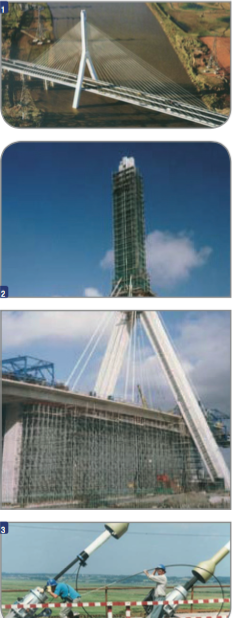 Stay Cable Installation
Stay Cable Installation
Client
Flintshire County Council
Architect
Percy Thomas Partnership
Consulting Engineers
Gifford Graham & Partners
Principal Contractor
NWH / Kier / SGE JV
Stay Cables & Post Tensioning
Freyssinet Ltd
Completion
Autumn 1997
Value
£5m
The Flintshire Bridge crosses the River Dee, linking Flintshire and Cheshire with Merseyside. The bridge is an asymmetric stay cable bridge with a 100m end span that acts as a counterweight to the 194m long main span. The deck is supported by 38 pairs of stay cables anchored to a 115m high pylon. A clear height of 18m above the river enables ships to pass. Freyssinet was responsible for stay cable installation and for prestressing of the main structure and the approach viaducts.
The inverted ‘Y’ pylon is supported on two 4m thick rafts connected by a stiffening beam. The pylon is formed from white coloured pre-cast segments with an in-situ filling. The upper part of the pylon includes an internal metal frame onto which the stay cables are anchored. Construction of the two access viaducts, one 390m long on the east side, and the other 270m long on the west side, was also a major part of the project.
Stay cables were installed after the deck slabs built by cantilever construction had been poured. Their length varies from 38 to 135 m, and they were anchored in the deck and the pylon by means of 37HD, 55HD and 61HD anchorages. The stay cables were then tensioned to between 2,000 and 5,600 kN using Freyssinet’s Isotension technique.
The main span deck is prestressed longitudinally and transversally. 40mm diameter Macalloy bars are used for longitudinal prestressing of deck segments. The transverse prestressing is provided by 19K15 tendons. There are two tendons in each concrete rib. Access spans are multiple concrete box girder bridges. A total of twenty-four 27K15 tendons were used in the six webs to provide longitudinal prestress. These tendons are coupled at the interface of each 40m section.
The bridge was one of only a few post-tensioned structures to be constructed in the UK during the Highways Agency’s four year moratorium on grouted post-tensioning. Through a series of trials, Freyssinet has convincingly demonstrated that grout completely fills the ducts. The use of HDPE ducts, sealed pressurised duct couplers and vents provided with purge valves has contributed to obtaining high quality complete grouting.
1 Aerial view of the bridge opened to traffic
2 Y pylon and cable stays during construction
3 Strand pushing
